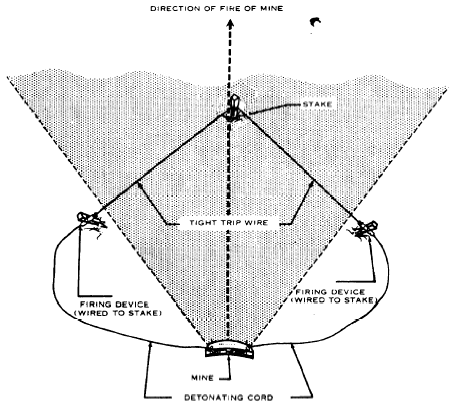Installation for Nonelectrical Firing Tripwire Initiation of the Mine (uncontrolled).
Instructions for laying, aiming, and arming the mine using two nonelectric M7 blasting caps, a piece of detonating cord approximately 25 feet long, a pull wire, and a pull-type or pull release-type firing device, such as the M1 or the M3 is discussed below. Instructions for laying, aiming, and arming the mine using a dual firing system and a ring main is discussed below. To arm the mine by the method described below, a thorough knowledge of explosives and demolition materials and the use and installation of land mines and boobytraps is required. Material on these subjects and techniques is contained in FM 3-5, FM 5-25, FM 5-31, FM 20-32, FM 31-10, TM 9-1375-200 and TM 9-1345-200.
Tripwire Initiation of the Mine (uncontrolled).
(1) Laying.
(a) Check to see that the mine and all accessories are in the bandoleer. Read the instruction sheet attached inside the bandoleer cover before installing the mine.
(b) Remove the electrical firing wire leaving the mine and other accessories in the bandoleer.
Warning: During installation the M57 firing device must be kept in the possession of the man installing the mine to prevent accidental firing by a second man.
(c) Secure the shorting plug end of the firing wire at the firing position. Place the bandoleer on your shoulder and unroll the firing wire to the position selected for emplacing the mine.
Note. The instructor sheet which accompanies the M18A1 mine with slit-type peepsight indicates that the firing wire can be unrolled from the mine or from the firing position; however, the firing wire should always be laid from the firing position to the mine emplacement.(d) Remove the mine from the bandoleer; turn the legs rearward and then downward. Spread each pair of legs about 45 degrees. One leg should protrude to the front and one to the rear of the mine. Position the mine with the surface marked “FRONT TOWARD ENEMY” and the arrows on top of the mine pointing in the direction of the enemy or the desired area of fire. On snow or extremely soft ground the bandoleer may be spread beneath the mine for support.
(e) To prevent tipping in windy areas or when the legs cannot be pressed into the ground, spread the legs to the maximum (about 180° so that the legs are to the front and rear of the mine.
(2) Aiming.
(a) Mines with slit-type peepsight.
1. Select an aiming point which is about 50 meters (150 feet) to the front of the mine and about 2½ meters (8 feet) above the ground.
2. Position the eye about 15 centimeters (6 inches) to the rear of the sight. Aim the mine by sighting through the peepsight. The groove of the sight should be in line with the aiming point. The aiming point should be in the center of the desired area of coverage, and the bottom edge of the peepsight should be parallel to the ground that is to be covered with the fragment spray.
(b) Mines with knife-edge sight.
1. Select an aiming point at ground level that is about 50 meters (150 feet) in front of the mine.
2. Position the eye about 15 centimeters (6 inches) to the rear of the sight. Aim the mine by alining the two edges of the sight with the aiming point.
(3) Crimp a nonelectric blasting cap to a firing device. With the nonelectric blasting cap attached, fasten the firing device to the detonating cord with tape. Using tape, wire, twine or cord, fasten the firing device securely to a firmly emplaced stake. Insert the detonating cord into a second nonelectric blasting cap and crimp the cap to the detonating cord. Carefully insert the cap into the detonator well. Secure the cap in the detonator well by carefully taping or tying the detonating cord to the mine..
(4) Attach a pull wire securely to the pull ring of the firing device. The pull wire should be sufficiently long to allow actuation of the firing device from a protected position at least 16 meters to the rear of the mine. Care must be taken during emplacement to secure the firing device so that the mine will not be dislodged by a pull of the detonating cord of the tripwire.
(5) The tripwire and the firing device, which are stretched across a trail or other avenues of approach, must be securely attached to two stakes firmly emplaced in the ground at a distance of 20 to 30 meters forward of the mine.

Diagram of the M18A1 Antipersonnel Mine installed for Uncontrolled firing